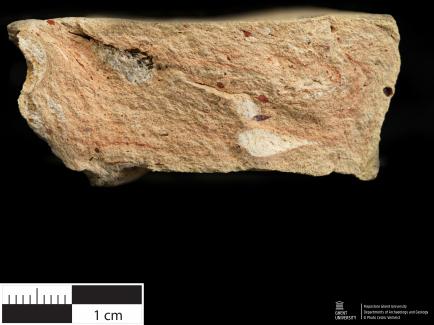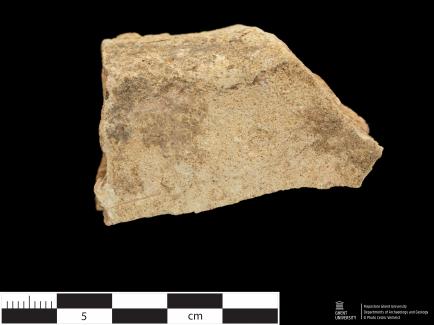Post Medieval - Ceramic building material (7.CBM.BE.0010)
Hand specimen pictures (macro & binocular)
Thin section pictures
Find location
- Category
- Ceramic building material (Post Medieval)
- Fabric name
- Chronology
- Post Medieval > Modern > 1595-1617
- Dating method(-s)
- historical sources, typology
- Potters' mark
- No
- Additional information
- stilt fragment, firing aid used to stack the vessels in the kiln
Find location
- Site type
- Pottery production
- Location
- Belgium; Antwerpen; Antwerpen
- Site name
- Antwerpen, Aalmoezenierstraat
- Excavation or Survey Team
- Afdeling Opgravingen, Stad Antwerpen
- Additional contextual information
- site code: A187 (Aalmoezenierstraat 43-47); context information: A187/2/HS23; excavation 2001 (kiln + production waste); attributed to the workshop/pottery company of Hans Boudewijns (atelier De Blompot)
- Surface color
- beige
- Surface texture
- Rough
- Fracture color
- beige; pink and red layered
- Inclusions (non-plastics/tempering)
- quartz; amorphous white/beige inclusions (?), orange red oval clay pellets (?), large (up to 0.5 cm) oval (clay ?) inclusions
- Matrix and voids
- small vesicles and vughs
- Diagnostic features
- Additional information
- sample ANTW_AAL_ST2
- Flepostore inventory nr.
- ARCH1.L1.C13
- Original inventory nr.
- A0054
- Collection
- Archaeological Department, Ghent University
- Type
- Covered thin section
- Comparable thin section(s)
- Matrix
-
oxidised white-orange fabric; dark brown (PPL), dark brown (XP).
Homogenous matrix, non-calcareous with no optical activity: matrix partly near sintering/vitrification due to overfiring.
- ca. 30-55% - Inclusions
-
Quartz (++; mono), sedimentary rock detritus (--; quartz arenite), feldspars (--; plagioclase, microcline, orthoclase), muscovite mica (-; el), O/Fe (+), clay pellets (+-; iron-rich).
The coarse fraction consists of fine to medium sand, the fine fraction consists of very fine to fine sand. Grains are generally subrounded to subangular. Overall the fabric is moderately sorted and orientated, close to single spaced.
- ca. 40-50% - Voids
-
Large vughs and small planar/channel/vughs, calcite and soil infill, moderately aligned.
- ca. 10-20% - Diagnostic features
- The fabric is characterized by a homogenous oxidised matrix with no optical activity (overfired: partly vitrified) and moderate porosity. Dominant quartz inclusions with frequent opaques/iron oxides, common iron-rich clay pellets, few muscovite mica, and rare sedimentary rock detritus and feldspars. Overall moderately sorted fabric.
- Additional information
- Similar to A0053: muscovite possibly altered or burned out, but higher volume of voids, also possible from overfiring.
- Sample type
- Building material (decorative, construction)
- Inventory number
- 7.CBM.BE.0010
- Collection
- Archaeological Department, Ghent University
- Donating institute/person
- Onroerenderfgoeddepot, Stad Antwerpen
- Host collection
- Onroerenderfgoeddepot, Stad Antwerpen
- Other samples available
- No
- Sample collection method
- Archaeological Excavation
Caignie 2015
- Full reference
-
Caignie F. 2015. Majolicategels uit de Braderijstraat. Rapporten van het Stedelijk informatiecentrum archeologie & monumentenzorg, 13.
Cite this page as: Flepostore - https://flepostore.ugent.be/ceramics/7-cbm-be-0010
Last modified: 2024-05-04.





